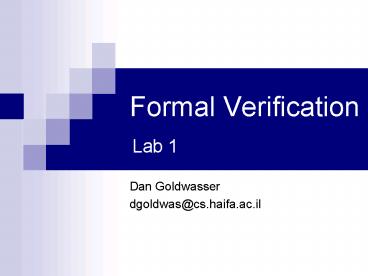Formal Verification Lab 1 PowerPoint PPT Presentation
1 / 16
Title: Formal Verification Lab 1
1
Formal Verification Lab 1
- Dan Goldwasser
- dgoldwas_at_cs.haifa.ac.il
2
Introducing FV
- What is formal verification?
- Establishing properties of system designs using
mathematical methods - Why use formal methods?
- Safety Critical Systems
- High Bug Costs
- Why Hardware?
- High bug costs
- Greater reliability requiered by costumers
- Feaseable (more or less)
3
Introducing FV
- How is it done?
- The method consists of a Model and a Property.
- The Methods output is an assurance that the
property holds or a counter-example
P always holds
Counter- example
p
4
Defining a Model
- Definitions
- State - snapshot of the values of variables at a
particular instant of time. - Finite state system - a system which has a
finite number of different states. - Transition the ordered pair ltstate before,
state aftergt - Computation - is an infinite sequence of states
where each state is obtained from the previous by
a transition
5
Defining a Model
- Intution
- A State (0,1)
- A Finite state system (0,0),(0,1),(1,0),(1,1)
- A Transition lt(0,0),(0,1)gt
- A Computation lt(0,0),(0,1),(1,0),(0,0),
(0,1),... gt
6
Kripke Structure
- Let AP be a set of atomic propositions
- A Kripke structure M over AP is a tuple
M(S,S0,R,L)where, - S is a finite set of states
- S0 ? S , the set of initial states
- R ? S x S, is a transition relation that must be
total, i.e., for every state s in S there is a
state s in S such that R(s,s). - L is a function that labels each state with the
set of all atomic proposition in AP that are true
in that state. - A path in M from s is an infinite sequence of
states ? s0s1s2, such that sos, and
R(si,si1) holds for all igt0.
7
Defining a Model
- M(S,S0,R,L)
- S s0,s1,s2,s3
- S0 (0,0) (system starts with Reset)
- R lt(0,0),(0,1)gt,lt(0,1),(1,0)gt,lt(0,1),(0,0) ...
gt - L (s0,(0,0)),(s1,(0,1)),(s2,(1,0)),(s3,(1,1))
inc
0
1
Reset
8
Temporal Logic
- logic with a notion of time included.
The formulas are interpreted over Kripke
structures, which can model computation. - Intution
- Propositional Logic Formula defines a set of
states - Temporal Logic Formula defines a set of
sequences of sets of states
9
Temporal Operators
- Eventually p p will eventually hold (Fp)
- Globally p - p will always hold (Gp)
- Next-time p p will hold at the next step (Xp)
- p Until q p holds until q holds (pUq)
- p,q is a temporal logic formula or a
propositional logic formula
10
Temporal Operators
- Eventually p p will eventually hold (Fp)
- qqqqq..qp...
- Globally p p will always hold
(Gp) pppppppp...pp.. - Next-time p p will hold at the next step
(Xp) qp.... - p Until q p holds until q holds (pUq)
- ppppq...
11
Linear time and Branch time
- Linear only one possible future in a moment
- Look at individual computations
- Branching may split to different courses
depending on possible futures - Look at the tree of computations
s3
s0
s2
s1
12
Path Quantifiers
- Branching time modeled with path quantifiers
- A f - f holds for all computation paths
- E f - f holds for some computation paths
13
Path Quantifiers
- Intuition
p
p
Temporal Operator Path quantifier
q
q
q
p
p
p
q
p
...
q
q
14
LTL and CTL
- LTL (Linear Temporal Logic) - Reasoning about
infinite sequence of states p s0, s1, s2, - CTL (Computation Tree Logic) Reasonning on a
computation tree. - Temporal operators are immediately preceded by a
path quantifier (e.g. A F p ) - CTL vs. LTL different expressive power
- EFp is not expressible in LTL
- FGp is not expressible in CTL
15
LTL
- Linear time operators.
- The following are a complete set p , p ? q
, X p, p U q - Others can be derived
- p ? q ? (p ? q)
- p ?q ? p ? q
- F p ? (true U p)
- G p ?(p U false)
16
CTL
- Temporal operators are immediately preceded by a
path quantifier - The following are a complete set p, p
? q , AX p , EX p , A( p U q), E( p U q) - Others can be derived
- EF p ? E(true U P)
- AF p ? A(true U p)
- EG p ? AF p
- AG p ? EF p

